|
|
|
|
|
|
This review page is supported in part by the sponsor whose ad is displayed above
|
|
 |
|
 |
|
Just like the CD128 before it, the SE-30A arrived securely clam-shelled, all tubes installed. In the three stapled sheets going for the owner's manual, a stern warning alerts one that tube bias adjustments may only be performed by a qualified technician. For everyone else, the proper bias voltage is 0.5V. My EL34s all sat at 0.55V +/- 0.01V upon delivery, suggesting a slightly different wall voltage from the factory but rock-solid biasing.
|
|
|
 |
|
Unlike the CD128, the chassis is polished stainless with its peculiar penchant for absorbing skin oils and discoloring. How to keep that as pristine as the gloss-lacquered transformer casings, the finely pebbled corner turrets and smoothly grained fascia is one of those questions. I'm told that future models will switch to aluminum (wasn't this a brand new model already?) The pale champagne footers are bolted into the corner stanchions and can easily be adjusted for perfect leveling.
|
|
|
|
 |
|
 |
|
| Like the recently reviewed Melody Hifi Ltd. I2A3 18-watter, the Raysonic integrated is preternaturally quiet on my 101dB Zus. Are we witnessing the dawn of a new epoch of affordable Chinese-built valve kit that completely transcends hiss and hum? Two out of two in two months is certainly suggestive and marvellous news. |
|
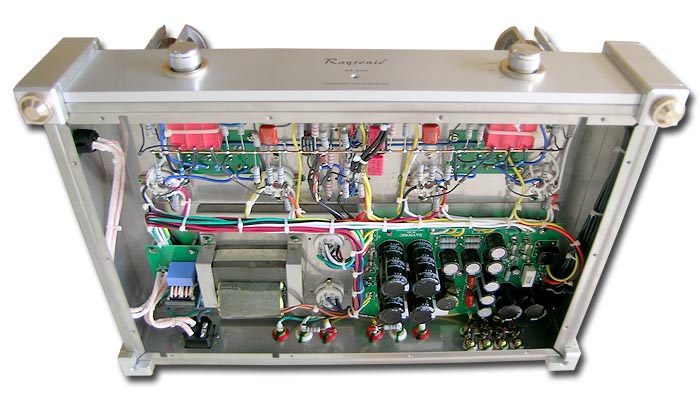 |
|
|
The innards are as tidy as its digital sibling's while not as busy. There's less stuff here.
|
|
 |
|
|
The Metropolis tube chimneys are permanently installed and quickly get scalding hot to the touch to perform a secondary -- or rather, primary -- function as fashionably sculpted heat sinks. They also make pulling the EL34s out somewhat of a challenge. Being a Class A design, this amp gets hot all over - chassis, potted transformer casings, the very air around it. This is not an amp you'll want to leave on while it's not playing. Unless it's winter of course and you don't mind thermally stressing the components more than necessary.
|
|
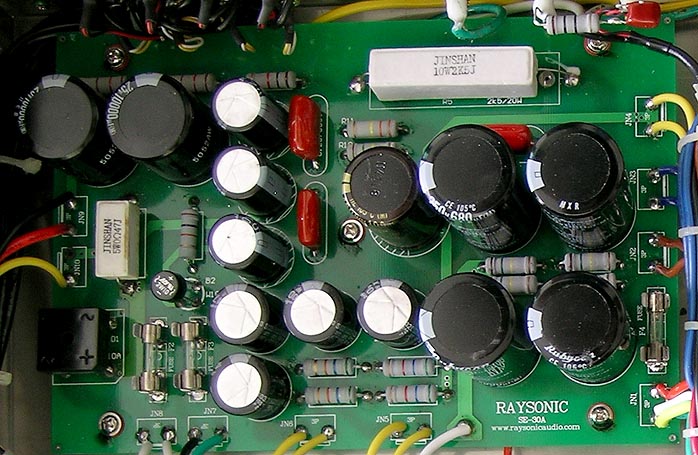 |
|
|
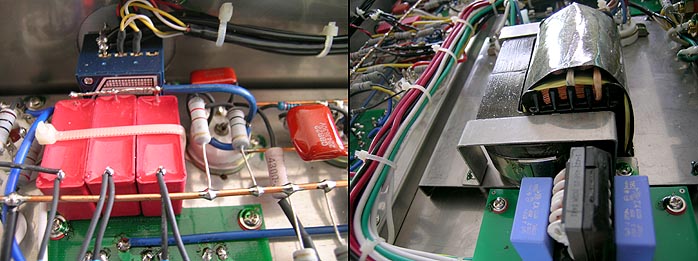 |
|
 |
|
While finished very nicely, the SE-30A isn't quite of the same outrageous caliber in that regard as its CD-128 stable mate. |
|
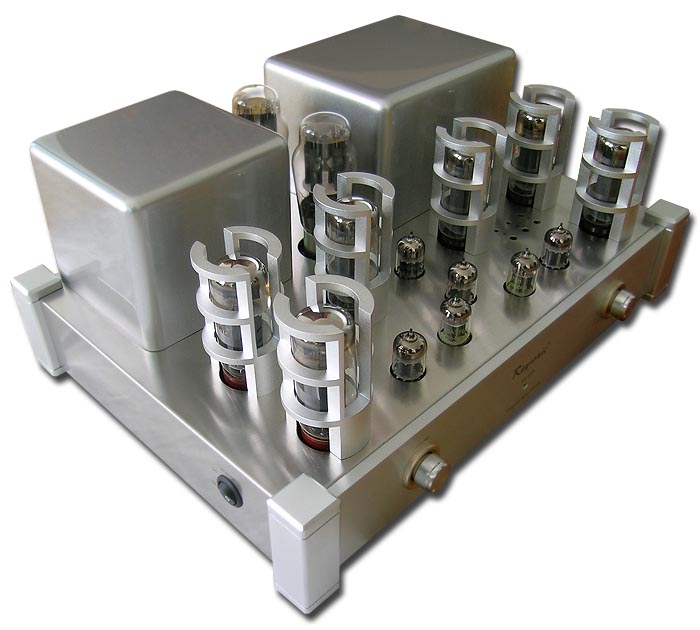 |
|
The SE-30A lacks remote control. Looking over its internal parts, they don't quite stretch the envelope as Melody's I2A3 did with its Jensen PIO caps and custom-made resistor-ladder attenuator. In the end, it's of course how well any chosen parts perform in the circuit. Because I had the Melody HiFi I2A3 and Eastern Electric M520 in house -- all similar in power, all below $3,000, the M520 the only one with remote -- I set up a system to compare all three. For source duties, the Raysonic CD128 spun the digits to make for a realistically priced mate. For load behavior into standard 88dB speakers, Anthony Gallo's Reference 3.1s got leashed up.
|
|
 |
When the amp crackled and popped in only one channel after a few hours of play, I knew I had a bad tube. But which one? Swapping out left and right banks of EL34s confirmed that getting them out of the tube chimneys was tricky - manageable but unnecessarily inconvenient. Banana or twist lock removal would be nicer to fully expose the tubes first rather than having to peel them out. As it is, one has to use finger tips to gain purchase on the small ledge between thinner tube base and thicker glass shaft and push up hard. Wiggling is impossible. In the end, one of the Electro-Harmonix 12AU7/ECC82s was the kaputnik though visual inspection afterwards netted no clues as to why. Luckily my small tube cache included a spare EH. Just like plug'n'play, the amp was dead quiet and operational again.
Having lived off tube amps for more than 10 years, valve failures have occurred few and far between. From Mesa Baron to Tigris, Art Audio Jota to PX-25, Audiopax Model 88s to Yamamoto A-08S, only one EML 45 quietly giving up its ghost sticks out in recent memory. Review amp loaners have misfired once or twice. To see a small-signal valve go bad is even rarer than an arcing power tube. In short, this didn't say anything bad about the Raysonic. There's light bulbs dying half a night into being screwed in. If you don't have a tube tester, the time-honored ritual of tracking bad tubes without light shows is by a process of elimination. Swap out one tube at a time with the opposite channel position until the problem appears in the other channel. Gotcha.
|
|
|
 |
|
To get the most out of the Ref 3.1's sealed 4-ohm woofer in its tiny enclosure naturally wants rather more current and drive than any of these tube integrateds would really deliver. For the sake of reporting on relative drive, bass control, achievable SPLs without distortion and sonic similarities under a bit of duress, however, this setup did make for a suitable proving ground.
While all of these integrateds managed sufficient SPLs, none in this larger room really made the Gallos lift off and fly. The Ref 3.1 is a very open and spacious speaker that's quick and nearly electrostatic in aspects. Now it sounded a bit shut in, veiled and sluggish particularly at standard and lower levels. It didn't quite live up to its Reference billing. Still, useful results were obtained. To wit, the Melody was the most agile and expressive of the three, the M520 the densest and buxomest, the Raysonic in the middle. While the M520 was fullest in the bass, the 2A3I displayed the most pitch definition there and elsewhere, with the Raysonic again in the middle. The 2A3 push/puller retrieved the most ambient detail followed by the Raysonic while the Mullard circuit threw the widest soundstage. The Eastern Electric was clearly warmish though with good macrodynamics -- those rare Mullard rectifiers -- while the Melody had the faster reflexes and airier top end. The Raysonic maintained its middle position throughout.
|
|
|
|
The Raysonic was a competent 'un then. It kept the pace with two recognized performers in this particular price and power range. Its single-ended circuit was leaner than the push/pull circuit of the M520. This slightly altered the profile of the EL34s which both amps share - though in neither application did I hear quite as much refinement, light and low-level ambient cues as I did from the 101D-flavored, 6SN7-driven 2A3s. For my tastes and sentiments, the Melody came first. It offered a higher level of micro resolution coupled to the most articulated dynamics and sophistication. The EL34 equipped amps were a bit more copperish in hue, a bit fuzzier, less distinct around the edges and less exciting even though the Eastern Electric held an advantage in overall verve and drive over the Raysonic.
|
|
 |
|
From an SPL perspective, all three amps made do on the Gallos. Predictably, the lowest two octaves lacked punch and grit compared to what I know the speaker can do. The major failing however was the overall veiling and lack of spark caused by insufficient overall current. The M520 did best though it was still shy of ideal. The general sound of this shootout conjured up plumbing in need of rotorooting. Stuff was moving but not as briskly and freely as it should have. For the SE-30A, I'd look at 92dB+ speaker sensitivity to hit its power sweet spot.
|
|
|
|
 |
|
Still, this exercise established a hierarchy under these conditions. While the Raysonic shares much with the Eastern Electric M520, the latter is $600 cheaper, includes full remote and offers a pre-in (naturally bypassing the volume control then and dropping circuit gain). The SE-30A is tonally slimmer, texturally leaner and a bit paler overall. The M520 is ballsier, with grander dynamic peaks and deeper tone colors. On a highly efficient load like my Zu, the Raysonic conversely holds one ace by being quieter in operation. Compared to the M520, Ray is indeed painting with a finer-tipped if less muscular and less thrilling brush overall.
On balance -- factoring in price and features beside performance -- the Raysonic for once is a bit overshadowed by a Chinese competitor rather than putting the favorable pricing screws on Western equivalents. I also wonder whether running its pentodes in SEP rather than SET mode could have tipped the balance in Raysonic's favor. Regardless, the Eastern Electric would still have won on price, on remote functionality, on adjustable feedback and ultralinear/pentode flexibility for user voicing options - and for lacking those tube chimneys which make swapping valves less than routine.
It's when you use the Raysonic into highly efficient speakers like my Zus -- that is, a bit outside of where I anticipate most of its target buyers would shop for boxes -- that it comes into its own. Because of its ultra-quiet operation; because of how the minor fatness and fuzziness of its EL34s are downplayed and diluted in its voicing then; because of how its faux triodes mimic certain real triode traits; this Raysonic piece should be thought of and dealt with as a micro-power SET. It simply has a bit more power under its hood than the micro denomination would suggest.
Needless to say, a triodized EL34 isn't exactly a 45. If it were, the DHT could pack its fancy Gucchi bags and go home. That kind of palpability -- of sharpness without sharpness that is conjoined to rich colors and extreme dimensionality -- is a little beyond the EL34s. Neither do they do the 300B magic of come-hither vocal voluptuousness. Run as pentodes, the EL34 probably would exhibit a bit more pungency and spice. As is, the Raysonic rang up Switzerland a bit in how it sat between the two other amps in a somewhat neutral zone. Neutral is good and, politically speaking, can save your bacon. In matters of the heart meanwhile, you might hope for a somewhat stronger statement.
|
|
 |
Bass extension and weight on the Raysonic are good but not groundbreaking - not that one would expect such from its basic concept. Treble reach is very solid while clearly not in the lit-up-without-being-bright leagues of 45s. The overall gestalt is more lithe than massive, a bit more polite than fully vibrant. It's a very competent amp that simply misses the greatness of the Melody (which might have to do with the latter's use of that 101D). Considering Raysonic's new M100 monos, the SE-30A with its angles and edges does clash a bit with its all-curves CD128 companion. It's as though two different design teams had worked separately on one model. With the M100 now using the CD-128 chassis turned sideways, Raysonic gets it.
|
|
|
Just five years ago, the choices in this sector -- affordable valve gear -- weren't as comprehensive yet. The Raysonic then would have sailed through graduation finals with half a crew on deck. Today and primarily due to its landsmen, the SE-30A faces far stiffer competition. How you'll judge it will very much depend on what you compare it to. On its own merit, you may indeed want for nothing. Were it not for the other options in my crib, I wouldn't have either. Especially for the very fair money Raysonic asks. In fairness, the Melody piece as my favorite in the above comparisons is more expensive so setting an even higher standard comes with the territory. Choices. The more the merrier they say but it's making it also harder and harder knowing where to begin the process. The SE-30A is an excellent place to begin.
|
|
|
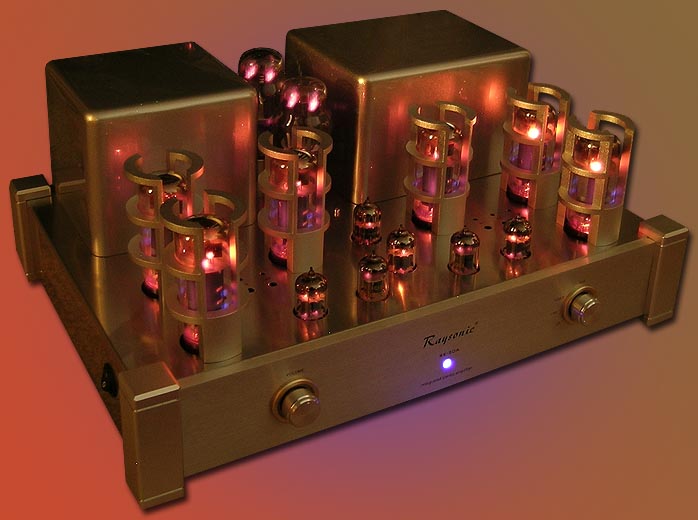 |
|
|
|
 |
|
|
|
|
|
 |
|
 |
|
|
|
|
|
 |
|
|
|
|
|
|
|
|
|
|
|
|
|
|
|
|